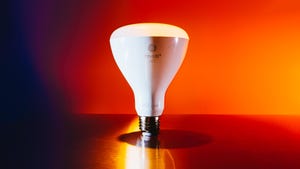A traditional light bulb isn’t bright or energy-efficient and doesn’t have extra capabilities. If you need these features, an LED bulb might suit your needs. Whether you’re looking for maximum brightness in the darker rooms of your home or want a light source that can be programmed to dim according to your schedule, we’ve found the best LED lights for long-term use, offering warm white, cool white and even multiple colors.
Read more: Best Smart Home Tech Gifts
So how do you choose the right LED lights for the job, especially with so many energy-efficient LED bulbs lining the shelves? The answer depends on how much time you use the light in a particular room. For example, if you’re a foodie who spends most downtime in the kitchen, you’ll need a brighter, more intense light. Or maybe you wind down and relax in your bedroom, where more intimate, warm lighting is key. With these thoughts in mind, you’ll be able to narrow down the options for your lighting needs.
If you’re still unsure of what to pick, here are some room-specific tips to help you zero in on the right LED lights for your living space. I’ve also included links so you can easily buy the light bulbs from our tests. I’ll keep them updated as I test new products.
If you have high ceilings, you’ll want floodlights that shine nice and bright in a single direction.
Chris Monroe/CNETLots of height? Make it super bright
From talking fridges to iPhones, our experts are here to help make the world a little less complicated.
If you have rooms with high ceilings or recessed lighting — an entryway, for instance, or maybe a staircase with overhead lights or a candelabra up above — you’ll want to prioritize brightness over softness in your light bulbs. After all, the higher up your light bulbs are, the brighter they’ll need to be in order to light up the room.
The most common products for overhead lighting are BR30-shaped floodlights. The “BR” stands for “bulging reflector,” and it means that the light inside the bulb sits above a reflective bowl, sort of like a little satellite dish. Screw a bulb like that up into your ceiling, and that bowl will catch all of the upward cast light, then reflect it back down and out the bottom, which bulges outward to produce the widest possible pool of bright light across the room. It’s the same trick your car’s headlights use to produce as much light output as possible out in front of you as you drive.
You’ve got plenty of energy saving BR30-shaped LED options in the lighting aisle. The most common choice among them are 65-watt replacement bulbs that typically put out about 650 lumens of light each. That’s a good, average number, and fine for average-height ceilings with at least a few bulbs shining overhead. Among the ones I’ve tested, 65-watt replacement floodlights from Cree and Philips are the two I’d recommend. They’re good values and they’re highly energy efficient for the money (each draws less than 10 watts). These dimmable bulbs also work well with dimmer switches and — most important for overhead lighting — they’re both nice and bright, each putting out comfortably more than 700 lumens. As of writing this, Home Depot has those Cree bulbs on sale in a two-pack for less than $6 each — they’re the ones I’d go with in my own home if it were me buying.
